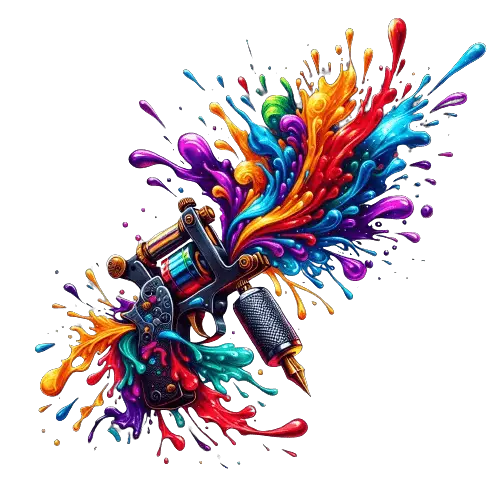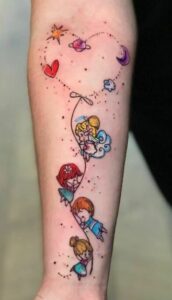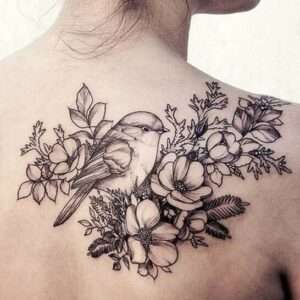A death tattoo symbolizes mortality and the fleeting nature of life. Death tattoos can represent grief, loss, or a reminder to live each day to the fullest.
They can also serve as a way to honor and remember loved ones who have passed away. Death tattoos typically feature skulls, grim reapers, or other macabre imagery, and can be designed in various styles such as realistic, traditional, or illustrative.
These tattoos often hold personal significance and can serve as a visual memento mori, prompting reflection on the impermanence of existence. Choosing to get a death tattoo is a personal decision and should be done after careful consideration of its meaning and significance.
The History And Origins Of Death Tattoos
Death tattoos have a deep-rooted history and carry significant meanings across various cultures throughout the world. These tattoos, often associated with remembrance, mortality, and the afterlife, have been an integral part of human expression for centuries. Let’s explore the diverse origins and symbolism of death tattoos in different cultures.
Native American Death Tattoo Traditions:
- Native american tribes have a rich history of death tattoo traditions.
- These tattoos often represent the connection between the living and the spirits of the departed.
- Key symbols used in native american death tattoos include skulls, feathers, and arrows, each carrying their own significance.
- The tattoos serve as a tribute to deceased loved ones and a reminder of the eternal nature of life and death.
Ancient Egyptian Symbolism Of Death Tattoos:
- Ancient egyptians had a profound fascination with death and the afterlife, which is reflected in their tattoo symbolism.
- Death tattoos were considered a way to protect and guide the deceased in their journey to the afterlife.
- Symbols such as the ankh (the key of life), scarabs, and hieroglyphs were commonly inked to represent rebirth and immortality.
- These tattoos were not limited to the deceased but were also worn by the living as a sign of their devotion to the gods and the belief in the afterlife.
Death Tattoos In Asian Cultures:
- Asian cultures have their unique approach to death tattoo symbolism.
- In japan, death tattoos, such as the yūrei (ghost) tattoo, symbolize departed souls seeking justice or vengeance.
- Chinese death tattoos often incorporate intricate designs with symbolic elements like dragons, koi fish, and cherry blossoms.
- Death tattoos in india can be seen in hindu culture, where devotees believe that death is a passage to the next life.
- These tattoos serve as a connection to the spiritual world and a way to honor ancestors.
The history and origins of death tattoos reveal the profound significance humans attach to the concept of mortality and the afterlife. From the native americans to the ancient egyptians and asian cultures, these tattoos continue to be powerful symbols that pay homage to departed loved ones and provide solace and connection to the spiritual realm.
Symbolism And Meanings Associated With Death Tattoos
Confronting Mortality: Death As A Reminder Of Life’S Transience
Death tattoos, though often seen as macabre or morbid to some, hold deep symbolism and meanings for those who choose to adorn their bodies with this type of artwork. In many cultures, death is viewed not only as an inevitable part of life but also as a powerful reminder of life’s transience.
Here are some key points to consider when exploring the symbolism and meanings associated with death tattoos:
- Memento mori: Latin for “remember you will die,” memento mori is a concept embraced by many who opt for death tattoos. These tattoos serve as constant reminders of the fleeting nature of life, urging individuals to live each day to the fullest.
- Embracing impermanence: Death tattoos can represent the acceptance of impermanence and the ephemeral nature of existence. They serve as powerful symbols of the cycle of life, encouraging individuals to appreciate the present moment and find beauty in the ever-changing world around them.
- Emotional resonance: For some, death tattoos hold personal significance, representing the loss of a loved one or a profound experience with mortality. These tattoos can provide a source of strength and healing, enabling individuals to carry the memory and the lessons learned from these experiences with them wherever they go.
These are just a few aspects to consider when contemplating the meaning behind death tattoos. Let’s now delve into another facet of their symbolism and significance.
Transformation And Rebirth: Death As A Gateway To New Beginnings
In many cultures, death is not seen as an end, but rather as a transformative process and a gateway to new beginnings. It symbolizes the cyclical nature of life, where death is a necessary step towards rebirth and renewal. Here are some key points to consider when exploring the transformational aspect of death tattoos:
- Metamorphosis: Death tattoos often incorporate imagery such as skulls or skeletal remains, symbolizing the shedding of old identities and beliefs, and the embrace of personal growth and transformation.
- Phoenix rising: In some tattoo designs, death is depicted as a phoenix rising from the ashes, representing the cycle of life and the potential for new beginnings that arise from the ashes of what was once lost.
- Embracing change: Death tattoos can also signify the courage to let go of the past and embrace change. They serve as a constant reminder that in order to grow and evolve, one must be willing to shed old patterns, beliefs, and behaviors that no longer serve them.
By embracing death as a gateway to transformation and rebirth, individuals who choose death tattoos can find solace in the ever-changing nature of life. Next, let’s explore another aspect of the symbolism behind these tattoos.
Connection To Ancestry And Heritage: Honoring The Departed
Death tattoos can also serve as a means to honor and remember loved ones who have passed away, offering a connection to ancestry and heritage. Here are key points to consider regarding the ancestral and commemorative significance of death tattoos:
- Ancestral remembrance: Death tattoos can be seen as a way to pay tribute to deceased family members or ancestors, ensuring they are not forgotten and carrying their spirit with you wherever you go.
- Cultural traditions: Many cultures have long-standing traditions surrounding death and the veneration of ancestors. Death tattoos can be a way to honor these cultural traditions and ensure they are preserved for future generations.
- Personal memorials: In some cases, death tattoos serve as personal memorials for friends, family, or loved ones who have passed away. They can be a visual representation of the deep emotional connections held with these individuals, allowing for a lasting tribute that transcends time.
Death tattoos can offer a powerful means of connecting with one’s roots, heritage, and departed loved ones. Whether seen as reminders of life’s transience, symbols of transformation, or memorials to honor the deceased, these tattoos hold deep and personal meanings for those who choose to wear them.
Various Depictions Of Death Tattoos
Death tattoos have become increasingly popular in recent years, symbolizing various meanings and personal interpretations. These tattoos often depict different aspects of death and mortality, serving as a reminder of the impermanence of life and the inevitability of our own mortality.
We will explore three popular depictions of death tattoos: grim reaper tattoos, skull tattoos, and hourglass tattoos. Each of these designs carries its own significant symbolism and adds a unique touch to the wearer’s body art. So, let’s delve into the meanings behind these various representations of death tattoos.
The Personal And Emotional Significance Of Death Tattoos
When it comes to expressing our emotions and memorializing our loved ones, death tattoos can hold deep personal and emotional significance. These tattoos serve as a therapeutic outlet for coping with loss and grief, a way to celebrate life and individuality, and a means to contemplate mortality’s role in life.
Let’s explore these three key aspects in more detail:
Coping With Loss And Grief: Using Tattoos As A Therapeutic Outlet
- Tattoos provide a tangible way to honor the memory of a loved one who has passed away.
- They can serve as a form of therapy, helping individuals process their grief and find solace in the permanence of a tattoo.
- Death tattoos serve as a constant reminder of the bond shared, allowing individuals to carry their loved ones with them wherever they go.
Celebrating Life And Individuality: Commemorating Loved Ones
- Death tattoos can be a beautiful way to celebrate the life and individuality of a loved one.
- Each tattoo design can be uniquely personalized, incorporating elements that represent the person’s personality, interests, or significant memories shared together.
- By commemorating loved ones with death tattoos, individuals are able to keep their spirit alive in a visually striking and meaningful way.
Finding Meaning And Purpose: Contemplating Mortality’S Role In Life
- Death tattoos prompt individuals to contemplate their own mortality and the finite nature of life.
- They can serve as a reminder to live each day to its fullest and appreciate the preciousness of life.
- Death tattoos can also symbolize the acceptance of mortality, allowing individuals to find a deeper sense of purpose and meaning in their own lives.
The personal and emotional significance of death tattoos goes far beyond their aesthetic appeal. They provide a therapeutic outlet for coping with loss, a way to celebrate the uniqueness of loved ones, and a catalyst for contemplating the role of mortality in our lives.
Whether you choose a small, discreet tattoo or a bold, elaborate design, each death tattoo holds a powerful and deeply personal meaning.
Cultures And Subcultures Embracing Death Tattoo Symbolism
The world of tattoo symbolism is vast, with countless meanings and interpretations to explore. One intriguing aspect of tattoo art is the embrace of death symbolism in various cultures and subcultures. From the gothic subculture to the vibrant celebrations of mexican day of the dead, and even the rebellious spirit of biker culture, death imagery holds a significant place in the tattoo world.
Let’s delve into these intriguing connections and uncover the meaning behind death tattoos in different cultural contexts.
Gothic Culture: Embracing Darkness And The Macabre
- Gothic culture has long been associated with an appreciation for the dark and macabre.
- Death tattoos within the gothic subculture often serve as expressions of individuality and a connection to the mysterious and unknown.
- Key elements of gothic death tattoo symbolism include skulls, coffins, crosses, and other symbols representing mortality.
- These tattoos can represent acceptance of the impermanence of life, as well as a fascination with the beauty found in darkness and the afterlife.
Day Of The Dead: Mexican Celebration Of Ancestors And Spirits
- The day of the dead, or día de los muertos, is a vibrant mexican celebration that honors and remembers deceased loved ones.
- Day of the dead tattoos are a meaningful way to pay tribute to ancestors and celebrate the cycle of life and death.
- Common elements in these tattoos include sugar skulls, marigolds, candles, and motifs representing spirits and joyous remembrance.
- These tattoos hold deep cultural significance and celebrate the belief that death is just a part of the natural cycle of existence.
Biker Culture: Incorporating Skull And Death Imagery
- The rebellious spirit of biker culture often incorporates skull and death imagery into tattoos.
- Skull tattoos, in particular, symbolize mortality and serve as reminders of the risks and dangers associated with the biker lifestyle.
- These tattoos can represent a fearless attitude towards life and death, as well as a brotherhood and camaraderie among bikers.
- Death-themed tattoos in biker culture are also a way to express an individual’s connection to the open road and the freedom that comes with it.
Death tattoo symbolism finds its place in various cultures and subcultures, each with its unique interpretation and significance. From the gothic fascination with darkness and the macabre, to the vibrant celebrations of the day of the dead in mexico, and the rebellious spirit of biker culture, death tattoos reflect individual beliefs, cultural traditions, and a profound connection to the cycle of life and death.
Whether as expressions of individuality, remembrance, or a statement of identity, these tattoos continue to captivate and inspire.
Popular Styles And Design Elements For Death Tattoos
Death tattoos hold deep symbolism and meaning for those who choose to adorn their bodies with these powerful designs. From intricate portraits of skulls and grim reapers to bold traditional motifs and minimalist symbol representations, there is a wide range of popular styles and design elements in the world of death tattoos.
In this section, we will explore three distinct styles that capture the essence of death tattoos: realism, traditional, and minimalistic designs.
Realism: Detailed Portraits Of Skulls And Grim Reapers
- Realism death tattoos are characterized by their lifelike and intricate depictions of skulls, skeletons, and grim reapers.
- These tattoos often feature detailed shading, highlighting, and fine lines to create a three-dimensional effect.
- Realism death tattoos allow for a deeper exploration of the macabre, capturing the dark allure and fascination with death.
Traditional: Bold Outlines And Vibrant Colors In Classic Death Tattoo Motifs
- Traditional death tattoos are rooted in the rich history and iconic imagery associated with death and mortality.
- The designs typically feature bold outlines, vibrant colors, and strong symmetrical compositions, making them instantly recognizable.
- Classic motifs such as skulls, hourglasses, scythes, and coffins are commonly used in traditional death tattoos.
Minimalistic: Simplified Silhouettes And Symbolic Representations
- Minimalistic death tattoos take a more subtle approach, utilizing simplified silhouettes and symbolic representations.
- These designs often focus on capturing the essence of death with minimalistic lines and negative space.
- Symbolic elements like feathers, roses, or clocks are used to convey meanings associated with mortality and the transient nature of life.
Whether you choose realism, traditional, or minimalistic designs, death tattoos provide an opportunity to explore the themes of mortality, memory, and the celebration of life’s impermanence. These tattoo styles offer unique ways to express one’s own interpretation of death and its significance in the human experience.
Placement And Size Considerations For Death Tattoos
Forearm Tattoos: Displaying Symbolism With Pride And Visibility
When it comes to death tattoos, the forearm is a popular choice for many individuals. The forearm offers a prominent placement that allows for easy visibility and showcases the symbolism behind the tattoo design. Here are the key points to consider when opting for a death tattoo on your forearm:
- Pride in symbolism: Forearm tattoos serve as a bold statement, displaying the significance and meaning behind the chosen death tattoo design. The visibility of the tattoo allows for the wearer to proudly showcase their beliefs and emotions associated with mortality.
- Easy visibility: Unlike tattoos on other body parts that may be hidden under clothing, forearm tattoos are easily visible to others. This visibility makes it ideal for those seeking to express their connection to the concept of death and the afterlife.
- Balance with other tattoos: The forearm provides ample space for incorporating additional tattoos, allowing for the creation of a cohesive design that complements the death tattoo. By choosing the forearm as a placement, individuals can develop a stunning and meaningful tattoo collection.
Chest And Back Tattoos: Larger Designs For More Elaborate Depictions
For those looking to make a bold statement with their death tattoo, the chest and back are prime locations. These larger canvases provide the opportunity for more intricate and elaborate depictions. Consider the following points when considering a death tattoo on your chest or back:
- Amplified symbolism: The larger space on the chest or back allows for more detailed depictions and symbolism. It offers an opportunity to incorporate complex scenes and elements that truly capture the depth and meaning associated with death.
- Expanded canvas: With ample space available, chest and back tattoos provide an extensive canvas for larger and more visually stunning designs. The size allows for attention-grabbing artwork that can leave a lasting impression.
- Personal expression: The chest and back are easily visible, especially during moments when one desires to proudly display their tattoo. These placements offer individuals the chance to express their personal connection to death and the afterlife on a grand scale.
Finger And Wrist Tattoos: Subtle Reminders Of Mortality
While some may prefer a more discreet approach when it comes to death tattoos, others find significance in subtle reminders of mortality. Finger and wrist tattoos offer a way to honor this concept in a more understated manner. Here are the key points to consider when choosing a death tattoo for your finger or wrist:
- Symbolic reminder: Finger and wrist tattoos serve as constant reminders of life’s transient nature. They can act as subtle prompts to reflect on mortality and make the most of the present moment.
- Subtle placement: The smaller area of finger and wrist tattoos offers a discreet placement that can be concealed if desired. This provides individuals with the option of a more private expression of their connection to death.
- Personal significance: Finger and wrist tattoos often hold deep personal meaning. They can represent an individual’s journey through life or serve as a tribute to a loved one. The intimate nature of these placements allows for a deeply personal and meaningful tattoo experience.
Remember, the placement and size of a death tattoo are important considerations. Whether you choose a forearm, chest, back, finger, or wrist tattoo, make sure it aligns with your personal symbolism and resonates with your own beliefs about mortality.
Choosing The Right Artist For A Death Tattoo
Researching Tattoo Artists With Expertise In Death Tattoo Symbolism
When it comes to getting a death tattoo, finding the right artist is crucial. You want someone who not only has the technical skills to create a beautiful tattoo but also understands the deep symbolism behind death tattoos. Here are some key points to consider when researching tattoo artists with expertise in death tattoo symbolism:
- Look for artists who specialize in dark and macabre themes. These artists often have a deep understanding of death symbolism and can help bring your vision to life.
- Research the artist’s background and experience. Look for artists who have a strong portfolio of death tattoos and can provide examples of their work.
- Read reviews and testimonials from previous clients. This will give you an idea of the artist’s professionalism, skill level, and ability to bring their client’s vision to reality.
- Consider the artist’s style and aesthetic. Every artist has their own unique style, so it’s important to find someone whose artistic vision aligns with yours.
- Don’t be afraid to reach out and ask questions. Communication is key when it comes to getting a death tattoo that truly represents your personal meaning and vision.
Reviewing Portfolios And Examining Skill In Depicting Life And Death Imagery
Before you commit to an artist, take the time to review their portfolio and examine their skill in depicting life and death imagery. Here are some key points to consider when reviewing portfolios:
- Look for a diverse range of death-themed tattoos in their portfolio. This will demonstrate their versatility and ability to create unique and meaningful designs.
- Pay attention to the quality of their linework and shading. A skilled artist will be able to create depth and dimension in their tattoos, bringing the imagery to life.
- Examine the artist’s attention to detail. Death tattoos often incorporate intricate symbols and elements, so it’s important to find an artist who can execute these details flawlessly.
- Consider how well the artist captures the emotions and symbolism associated with death. Look for tattoos that evoke a sense of darkness, mystery, and introspection.
- Take note of the overall composition and balance of the tattoos in their portfolio. A well-designed death tattoo should be visually striking and harmonious.
Communication And Collaboration: Expressing Personal Meaning And Vision
When it comes to death tattoos, they hold significant personal meaning and vision. Communication and collaboration with your chosen tattoo artist are essential for bringing your vision to life. Here are some key points to consider when expressing personal meaning and vision:
- Schedule a consultation with the artist before getting your tattoo. This will allow you to discuss your ideas, symbolism, and personal meaning behind the tattoo.
- Share any reference materials or images that resonate with your vision. This will provide the artist with a visual representation of your desired outcome.
- Be open to the artist’s suggestions and ideas. A skilled tattoo artist can provide valuable insights and suggestions based on their expertise in death tattoo symbolism.
- Maintain clear and open communication throughout the process. Regularly communicate with the artist to ensure that the design aligns with your vision and any necessary adjustments can be made.
Remember, a death tattoo is not just a piece of art—it’s a deeply personal expression of your beliefs, emotions, and experiences. By researching tattoo artists with expertise in death tattoo symbolism, reviewing portfolios, and engaging in open communication, you can find an artist who can bring your vision to life in a way that truly honors and represents your personal meaning.
Frequently Asked Questions For Death Tattoo Meaning
How Do People Interpret Death Tattoos?
Death tattoos can be interpreted as a way to honor a loved one, symbolize mortality, or embrace the concept of life and death.
What Are Some Common Symbols Used In Death Tattoos?
Common symbols used in death tattoos include skulls, skeletons, grim reapers, hourglasses, tombstones, and mourning symbols.
Can Death Tattoos Have Positive Meanings?
Yes, death tattoos can have positive meanings as they can symbolize resilience, overcoming challenges, or embracing the cycles of life and death.
Conclusion
Death tattoo meaning is deeply rooted in personal interpretations and is a way for individuals to express their feelings and beliefs about mortality. It is a symbol that carries diverse connotations, representing both the darkness and fragility of life, as well as transformation and rebirth.
The vast range of death tattoo designs, such as skulls, hourglasses, and tombstones, allows for customization and personalization, enabling the wearer to convey their unique perspective on death. Whether one chooses to embrace the inevitability of death or use the tattoo as a reminder to live life to the fullest, the symbolism behind these tattoos is powerful and significant.
With the rise of popularity in body art, death tattoos continue to gain traction as a means of self-expression. The meaning behind a death tattoo resonates with those seeking a permanent reminder of the cycle of life and death, making it an impactful choice for many individuals.




